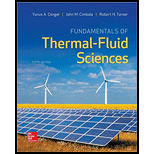
The pressure drop across a single tube and power required by the pump and the reduction in flow rate due to scaling.
Explanation of Solution
Given:
Diameter of the tube is 1cm.
Length of the tube is 1.5m.
Temperature of water is
Rate of flow is
Number of brass tubes is 80.
Calculation:
Refer Table A-15 “Properties of saturated water” from Appendix 1 and obtain the following properties of ammonia.
Calculate the velocity of the flow.
The Reynolds number is
Since the Reynolds number is greater than 2300, the flow is turbulent. Hence, the friction factor is obtained from Moody chart as follows:
On solving the above equation, we get
Calculate the pressure drop.
Thus, the drop in pressure across a single tube is
Calculate the power required by the pump.
Thus, the power required by the pump is
After the buildup of scale:
The velocity of the flow is,
The Reynolds number is
The friction factor is obtained from Moody chart.
The pressure drop is,
The power required by the pump is,
We have 5 equations and 5 variables. Solving the system of simultaneous equations, we get:
Calculate the reduction in the flow rate.
Thus, the reduction in the flow rate after scaling is
Want to see more full solutions like this?
Chapter 14 Solutions
Fundamentals of Thermal-Fluid Sciences
 Elements Of ElectromagneticsMechanical EngineeringISBN:9780190698614Author:Sadiku, Matthew N. O.Publisher:Oxford University Press
Elements Of ElectromagneticsMechanical EngineeringISBN:9780190698614Author:Sadiku, Matthew N. O.Publisher:Oxford University Press Mechanics of Materials (10th Edition)Mechanical EngineeringISBN:9780134319650Author:Russell C. HibbelerPublisher:PEARSON
Mechanics of Materials (10th Edition)Mechanical EngineeringISBN:9780134319650Author:Russell C. HibbelerPublisher:PEARSON Thermodynamics: An Engineering ApproachMechanical EngineeringISBN:9781259822674Author:Yunus A. Cengel Dr., Michael A. BolesPublisher:McGraw-Hill Education
Thermodynamics: An Engineering ApproachMechanical EngineeringISBN:9781259822674Author:Yunus A. Cengel Dr., Michael A. BolesPublisher:McGraw-Hill Education Control Systems EngineeringMechanical EngineeringISBN:9781118170519Author:Norman S. NisePublisher:WILEY
Control Systems EngineeringMechanical EngineeringISBN:9781118170519Author:Norman S. NisePublisher:WILEY Mechanics of Materials (MindTap Course List)Mechanical EngineeringISBN:9781337093347Author:Barry J. Goodno, James M. GerePublisher:Cengage Learning
Mechanics of Materials (MindTap Course List)Mechanical EngineeringISBN:9781337093347Author:Barry J. Goodno, James M. GerePublisher:Cengage Learning Engineering Mechanics: StaticsMechanical EngineeringISBN:9781118807330Author:James L. Meriam, L. G. Kraige, J. N. BoltonPublisher:WILEY
Engineering Mechanics: StaticsMechanical EngineeringISBN:9781118807330Author:James L. Meriam, L. G. Kraige, J. N. BoltonPublisher:WILEY





